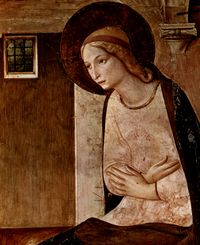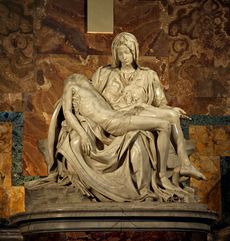Blessed Virgin Mary
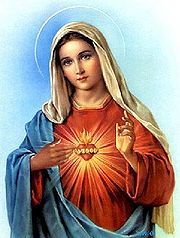
- This ecumenical article is about general Christian views on and veneration of the Virgin Mary. For specific views, see Blessed Virgin Mary (Roman Catholic), Mary (mother of Jesus), Anglican Marian theology, Lutheran Marian theology, Protestant views on Mary and Islamic view of Virgin Mary. For the religious order BVM, see Sisters of Charity of the Blessed Virgin Mary.
The Blessed Virgin Mary, also the Blessed Virgin and the Virgin Mary, are titles of Mary, the mother of Jesus, who is is venerated in Christianity, especially the Catholic and Orthodox churches.
Since the first century, devotion to the Virgin Mary has been a major element of the spiritual life of a vast number of Christians, primarily in Catholicism. From the Council of Ephesus in 431 to Vatican II and Pope John Paul II's encyclical Redemptoris Mater, the Virgin Mary has come to be seen not only as the Mother of God (Θεοτόκος Theotokos) but also as the Mother of the Church, a Mediatrix who intercedes to Jesus Christ and even a proposed Co-Redemptrix.
The key role of the Virgin Mary in the beliefs of many Christians, her veneration, and the growth of Mariology have not only come about by the Marian writings of the saints or official statements but have often been driven from the ground up, from the masses of believers, and at times via reported as Marian apparitions, miracles, and healings.
Contents |
Veneration of the Virgin Mary
There is a long-standing and widespread tradition in Catholic, Orthodox, Coptic, Syriac and Anglican Christianity of giving special honor and devotion to the Virgin Mary, mother of Jesus.
|
Key articles on |
|---|
|
General perspective |
|
Specific views |
| Key prayers & devotions |
|
Ecumenical |
Origins
Over considerable resistance, the Council of Ephesus in 431 formally sanctioned devotion to the Virgin as Theotokos, Mother of God, (more accurately translated as God bearer), sanctioning the creation of icons bearing the images of the Virgin and Child. Devotion to Mary was, however, already widespread before this point, reflected in the fresco depictions of Mother and Child in the Roman catacombs (illustration. left). The early Church Fathers saw Mary as the "new Eve" who said "yes" to God as Eve had said no.[1] The non-canonical Gospel of James, written around 150, is a literary testament to the earliest devotion to Mary, the first document advocating her perpetual virginity. Mary, as the first Christian Saint and Mother of Jesus, was deemed to be a compassionate mediator between suffering mankind and her son, Jesus, who was seen as King and Judge. Biblical support for this position was found in the story of the Marriage at Cana whereat Mary entreated Jesus to turn water into wine (Gospel of John, Chapter 2). Elizabeth's praise of Mary "blessed art thou among women" and "who am I that the mother of my Lord would visit me?" in Luke 2 are also cited in support of Mary's role, among other passages of Scripture.
In the East, devotion to Mary blossomed in the sixth century under official patronage and imperial promotion at the Court of Constantinople.[2] The popularity of Mary as an individual object of devotion, however, only began in the fifth century with the appearance of apocryphal versions of her life, interest in her relics, and the first churches dedicated to her name, for example, S. Maria Maggiore in Rome.[3] A sign that the process was slower in Rome is provided by the incident during the visit of Pope Agapetus to Constantinople in 536, when he was upbraided for opposing the veneration of the theotokos and refusing to allow her icons to be displayed in Roman churches.[4] Early seventh-century examples of new Marian dedications in Rome are the dedication in 609 of the pagan Pantheon as Santa Maria ad Martyres, "Holy Mary and the Martyrs",[5] and the re-dedication of the early Christian titulus Julii et Calixtii, one of the oldest Roman churches, as Santa Maria in Trastevere.[6] The earliest Marian feasts were introduced into the Roman liturgical calendar by Pope Sergius I (687-701).[7]
Early representations of Mary show her as the "Throne of Heaven" with Mary and the Child Jesus both royally crowned with Byzantine diadems. She was further identified with the Bride in the Old Testament Song of Solomon, by such noted theologians as St. Bernard of Clairvaux. She became the prototype for the Church itself. During the Middle Ages, and especially in France, the great Cathedrals were thus named for Mary. The Marian Rosary was popularized by the followers of St. Dominic.
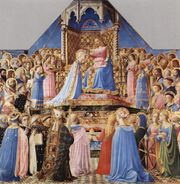
The image of Mary as Queen was softened somewhat by Mary as Mother of the Child Jesus. St. Francis of Assisi popularized the image of the Nativity scene using live animals. This representation of the helpless Jesus suckled by his mother brought Christmas into the hearts and homes of the people. And, as journeys to the Holy Land became difficult, Mary's role in the Passion story became part of the popular Stations of the Cross as the Mother of the suffering Jesus. During the great plagues such as the Black Death, Mary became greatly popular as a compassionate intercessor and protector of mankind against the just judgment of God.
Devotion to the Virgin Mary as the "new Eve" lent much to the status of women during the Middle Ages. Women who had been looked down upon as daughters of Eve, came to be looked upon as objects of veneration and inspiration. The medieval development of chivalry, with the concept of the honor of a lady and the ensuing knightly devotion to it, not only derived from the thinking about the VirginMary, but also contributed to it.[8] The medieval veneration of the Virgin Mary was contrasted by the fact that ordinary women, specially those outside aristocratic circles were looked down upon. Although women were at times viewed as the source of evil, it was Mary who as mediator to God was a source of refuge for man. The development of medieval Mariology and the changing attitudes towards women paralleled each other and can best be understood in a common context.[9] This reinterpretation of women flowered in the Courtly Love poetry of Medieval and Renaissance France. Mary, as the original "vessel of Christ" may have also influenced the legends of the Holy Grail. Her selflessness, obedience and virginal humility were reinterpreted in the literary figure of Sir Galahad, finder of the Grail.
Marian prayers and devotions
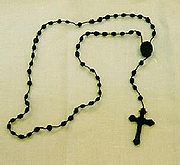
The earliest known prayer addressed to Mary is the Sub tuum praesidium, or Beneath Thy Protection, dating to the second half of the 3rd century. A papyrus dated to c. 250 containing the prayer in Greek was discovered in Egypt in 1917, and is one of the earliest known references to the title Theotokos, confirmed by the Council of Ephesus in 431:
- Beneath your compassion, We take refuge, O Mother of God: do not despise our petitions in time of trouble: but rescue us from dangers, only pure, only blessed one.
In the twelfth century indications of a regular devotion can be noted in a sermon by Bernard of Clairvaux (De duodecim stellis), from which an extract has been taken by the Roman Catholic Church and used in the Offices of the Compassion and of the Seven Dolours. Stronger evidences are discernible in the pious meditations on the Ave Maria and the Salve Regina, usually attributed either to St. Anselm of Lucca (d. 1080) or Bernard of Clairvaux; and also in the large book "De laudibus B. Mariae Virginis" (Douai, 1625) by Richard de Saint-Laurent.
The central role of Mary in the belief and practice of Catholicism and Orthodoxy is reflected in the fact that many churches contain side altars dedicated to the Virgin Mary, or statues and icons, often with candles that can be lit to accompany prayer.
Rosary and Scapular

Two popular Marian devotionals are the Rosary and the Scapular. They continue to be supported and linked as Marian Sacramentals by various religious figures.[10][11]
The Holy Rosary, a form of prayer in which an Our Father, ten Hail Marys and a Glory Be to the Father (together forming a "decade of the Rosary") are recited five times while meditating on the mysteries of the life of Jesus and Mary (Joyful, Luminous, Sorrowful and Glorious) to be followed by a prayer called the "Hail Holy Queen" and perhaps the "Litany of Loreto". The rosary as a "devotional path" to the Virgin Mary has been a source of inspiration for a number of Roman Catholic figures. For instance, in his encyclical Rosarium Virginis Mariae Pope John Paul II discusses the inspiration of the rosary and how his motto "Totus Tuus" was inspired by the writings of Saint Louis de Montfort.[12] Rosary beads are not always used for purely Marian prayers, and other Rosary based prayers (e.g. Rosary of the Holy Wounds directed to Jesus Christ) also exist in the Roman Catholic tradition.[13]
The Mariologicalbasis of the Scapular devotion is effectively the same as Marian consecration, namely the role of the Virgin Mary as "the mother to us in the order of grace".[14][15] Pope John Paul II stated that: [16]
Scapular is essentially a habit which evokes the protection of the Blessed Virgin Mary in this life and in the passage to the fullness of eternal glory.
Pope John Paul II also stated that he received his own first Brown Scapular of Mount Carmel at age ten when his Marian devotion was taking shape and he continued to wear it into his papacy.[17]
Reparations to the Blessed Virgin

Roman Catholic tradition includes specific prayers and devotions such as the Acts of Reparation to the Virgin Mary for insults that she suffers. Marian art depicting a sorrowful Virgin Mary is at times associated with these prayers.
The Raccolta Catholic prayer book (approved by a Decree of 1854, and published by the Holy See in 1898) includes a number of such prayers.[18][19][20] These prayers do not involve a petition for a living or deceased beneficiary, but aim to repair the sins of others against the Virgin Mary.
Other prayers
Other famous Marian prayers include the "Magnificat", the Angelus and the Litany of the Blessed Virgin Mary. Marian hymns include O Mary, we Crown Thee With Blossoms Today, Hail Queen of Heaven, the Regina Coeli, and the Ave Maria. May and October are traditionally seen within Roman Catholicism as Marian months.
The Little Office of the Blessed Virgin Mary is a weekly cycle of prayers said throughout the day, based on the Liturgy of the Hours, and consists of hymns, psalms, scripture, and patristic readings.
Marian apparitions
The Virgin Mary is also venerated at major religious sites around the world where it is believed that apparitions or appearances of the Virgin have occurred. In many places the witnesses to these appearances have said that important messages for humanity were delivered by the Virgin.
Popular devotions to the Blessed Virgin Mary associated with Marian apparitions include the Immaculate Heart of Mary, Our Lady of Lourdes, Our Lady of Fatima and Our Lady of Guadalupe.
The term Marian apparition is normally used in cases where visions of just the Virgin Mary herself are claimed. There have also been visions, such as those of Padre Pio and Sister Maria Pierina De Micheli, where visions of Jesus and Mary and conversations with both have been reported.[21][22]
Marian art
The Virgin Mary has been one of the major subjects of Christian Art, Catholic Art and Western Art since the 3rd century AD. Some of the leading Marian subjects include:
|
|
Marian church music
The Virgin Mary is highlighted in Catholic Church music through the ages. The ancient Latin Gregorian Chant masses include two Marian masses In solemnitatibus et Festis Beatae Mariae Virginis and in Festis et Memoriis[23] One of the earliest Marian compositions outside of the Gregorian chant is the popular Salve Regina in Latin from a Benedictine monk, which exists in several Gregorian versions. Other Marian supplications exist in numerous Latin versions as well[24] The List of compositions by Giovanni Pierluigi da Palestrina includes numerous Marian masses:
- Missa Salve Regina
- Missa Alma Redemptoris
- Missa Assumpta est Maria
- Missa Regina coeli
- Missa de beata Virgine
- Missa Ave Regina coelorum
- Missa Descendit Angelus Domini
- Missa O Virgo simul et Mater
Vivaldi, Monteverdi, Mozart, Haydn and others are well known composers who contributed to Marian music. Less known is the fact, that before 1802, the secularisation, many religious congregations had their own composers.[25] A totally unknown Father Valentin Rathgeber OSB, (1682–1750) wrote 43 masses, 164 offertories 24 concerts and, 44 Marian antiphones. Missa de Beata Virgine and the Messe de Nostre Dame are examples of individual contributions. Monteverdi's Vespro della Beata Vergine has remained structurally unchanged for the past 1500 years. Joseph Haydn wrote several Marian compositions including two famous Marian Masses:[26] Wolfgang Amadeus Mozart composed in honour of the Virgin Mary Latin masses and several shorter opera:[27] Other known classic composers with Marian compositions mainly in Latin include Orlando di Lasso and Franz Schubert.
Marian titles
- See main article: Titles of Mary
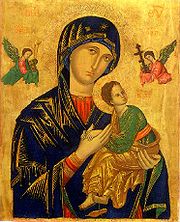
The Virgin Mary is known by many titles. Some of these titles are dogmatic in nature, referring to Marian beliefs that the Church views as necessary for salvation. Many other titles are poetic or allegorical and have lesser or no canonical status, but which form part of popular piety, with varying degrees of acceptance by the clergy. Yet more titles refer to depictions of the Virgin Mary in the history of art.
Among the most prominent Marian titles in the Roman Catholic Calendar are:
- Mary, Mother of God
- Mary, the Immaculate Conception
- Mary, Queen of Heaven
- Our Lady of Sorrows
- Queen of Angels
- Queen of Peace
- Star of the Sea (Stella Maris)
Among the most prominent Marian titles in the Eastern Orthodox and Greek-Catholic liturgical calendars are:
- Aeiparthenos Maria (forever virgin Mary)
- Axion Esti (it is worthy to bless Thee, the Virgin)
- Hyperagia Theotokos (most Holy Mother of God)
- Panagia Despoina (Our Lady and Queen)
- Panagia Evangelistria (Our Lady of the good Tidings)
- Panagia Myrtidiotissa
Marian feasts
During the month of May, May devotions to the Blessed Virgin Mary take place in many Catholic regions. There is no firm structure as to the content of a May devotion. It includes usually the singing of Marian anthems, readings from scriptures, a sermon, and or presentation by local choirs. The whole rosary is prayed separately and is usually not a part of a Marian devotion, although Hail-Marys are included.[28]
Traditionally, the month of October is "rosary month" in the Catholic Church, when the faithful are encouraged to pray the rosary if possible. Since 1571, Mary, Queen of the Holy Rosary, is venerated on October 7.[29] Pope Benedict XVI, following all his predecessors, also encourages the rosary during the month of October:
Among the most prominent Marian feast days in the ordinary Roman Catholic Calendar are:[30]
- January 1 Mary, Mother of God
- February 11 Our Lady of Lourdes
- March 25 Annunciation
- May 1 Queen of Heaven
- May 13 Our Lady of Fátima
- May 24 Mary Help of Christians patron of Australia
- May 31 Visitation of the Blessed Virgin Mary
- July 16 Our Lady of Mount Carmel
- August 15 Assumption into Heaven
- August 22 Queenship of Mary
- September 8 Nativity (birth) of the Blessed Virgin Mary
- September 15 Our Lady of Sorrows
- October 7 Feast of the Most Holy Rosary
- December 8 Feast of the Immaculate Conception
- December 12 Our Lady of Guadalupe
Among the most prominent Marian feast days in the Eastern Orthodox and Greek-Catholic liturgical calendars are:
- March 25 Annunciation of the Theotokos
- August 15 Dormition of the Theotokos
- September 8 Nativity of the Theotokos
- November 21 Entry of the Theotokos into the Temple
- December 26 Synaxis of the Theotokos
Roman Catholic views
Dogmas and titles
Some theological background is helpful for an understanding of the Virgin Mary in Catholicism. The principal Marian doctrines that have been dogmatically defined by the Roman Catholic Church are summarized below. Fuller details are to be found in the main articles.
Mother of God
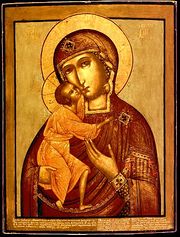
The dogma that declared Mary as being truly the Mother of God or Theotokos is the central dogma within Mariology. It is a De Fide doctrine in Catholicism: its denial is considered as heresy.[31] The Council of Ephesus declared:
- Therefore we confess one Christ, one Son, one Lord. According to this understanding of the unconfused union, we confess the holy virgin to be the mother of God because God the Word took flesh and became man and from his very conception united to himself the temple he took from her.
This is the oldest of all dogmas concerning the Blessed Virgin. It is not only essential in Marian Theology but also in the Theology of Christ. For if Mary was not Mother of God, then Jesus was in fact not God.[32]
This oldest dogma has given rise to extended Roman Catholic Mariological views in the 20th century. In Redemptoris Mater, Pope John Paul II commented on the self-referential nature of being the Mother of God, by stating: "To the wonderment of nature you bore your Creator!" and in his 1946 publication Compendium Mariologiae, respected Mariologist Gabriel Roschini explained that Mary did not only participate in the birth of the physical Jesus, but, with conception, she entered with him into a spiritual union. Most Mariologists agree with this position.[33]
Perpetual virginity
Mary was a Virgin before, during and after the birth of Christ (De Fide) This was taught by several writers including Ambrose of Milan, Augustine of Hippo, and the Lateran Synod in the year 649 under Pope Martin I. The Catholic Church interprets virginity as including mental virginity (virginitas mentis), sensual virginity (virginitas sensus), that is freedom from sexual desires and corporal virginity (virginitas corporis). The dogma of the Perpetual Virginity of Mary defines the latter. Mary was always a virgin, even after giving birth to Christ. Jesus's birth sanctified his mother's virginity.[34][35]
Immaculate Conception
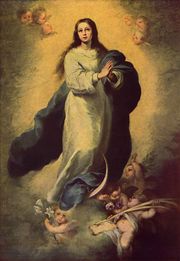
The Roman Catholic dogma concerning the Immaculate Conception of Mary teaches (De Fide) that Mary – unique among all human beings in history – was born without Original Sin and never sinned throughout her life. Although the sinlessness of Mary had been held by the church since the earliest times, the means by which this came about had long been a matter of dispute. The belief that Mary must have been freed of original sin at the very moment of conception gained greater acceptance in the 13th century. The doctrine was finally made binding by Pope Pius IX on December 8, 1854. The official Papal Bull entitled Ineffabilis Deus states:
- We declare, pronounce, and define that the doctrine which holds that the most Blessed Virgin Mary, in the first instance of her conception, by a singular grace and privilege granted by Almighty God, in view of the merits of Jesus Christ, the Savior of the human race, was preserved free from all stain of original sin, is a doctrine revealed by God and therefore to be believed firmly and constantly by all the faithful
This doctrine should not be confused with the miraculous conception of Jesus. The "Immaculate Conception" refers to Mary's own conception and birth – not to the famous miracle by which Jesus was conceived within her. Mary still needed a savior, since without Christ she would not have been preserved from original sin.
This doctrine should also not be confused with Mary's preservation from actual sin, although it follows logically that if she were freed from original sin, which is in essence a lack of sanctifying grace, she would have been free of the disordered inclinations to sin which are the result of a lack of sanctifying grace.
Assumption of Mary
It was not until 1950 that it was officially pronounced a dogma by Pope Pius XII in his papal bull Munificentissimus Deus. The Pope defined the dogma in these words:
We pronounce, declare, and define it to be a divinely revealed dogma: that the Immaculate Mother of God, the ever Virgin Mary, having completed the course of her earthly life, was assumed body and soul into heavenly glory.
While Pope Pius XII deliberately left open the question of whether Mary died before her Assumption, the more common teaching of the early Fathers is that she did.[37][38]
Mother of the Church
The title, Mother of the Church, which is not a dogma in the narrow sense, was a theme of the writings of Augustine of Hippo. It was proclaimed by Pope Paul VI at the Second Vatican Council in 1964. The title, Mother of the Church is a parallel to a more ancient title, Mary, Mother of all Christians which is based on a traditional Catholic interpretation of John 19:25-27:
Jesus' mother stood near his cross... Jesus saw his mother. He also saw the follower that he loved very much standing there. He said to his mother, "Dear woman, here is your son." Then Jesus said to the follower, "Here is your mother."
The traditional Catholic interpretation is that the "beloved disciple" is a type for all Christians who are beloved disciples. Thus, Jesus gives all Christians his mother as their own. As Mother of all Christians, Mary is Mother of the Church. An alternative interpretation is that Jesus was referring only to the Apostle John, asking John to fulfill a son's duty.
In his encyclical Redemptoris Mater, on March 25, 1987, Pope John Paul II said:
Mary embraces each and every one in the Church, and embraces each and every one through the Church. In this sense Mary, Mother of the Church, is also the Church's model.
The title Mother of the Church was again affirmed by him at a general audience on September 17, 1997.[39]
Marian shrines
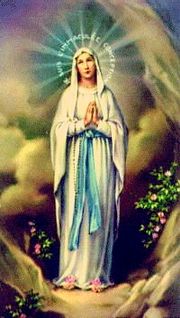
Modern popular image of the Lourdes Apparition.
In the culture and practice the Roman Catholic Church - a shrine to the Virgin Mary or Marian shrine is a shrine marking an apparition or other miracle ascribed to the Blessed Virgin Mary, or a site on which is centered a historically strong Marian devotion.
Some of the largest shrines are due to reported Marian apparitions to young and simple people on remote hilltops that had hardly been heard of prior to the reported apparition. The case of Saint Juan Diego's reported vision of Our Lady of Guadalupe in 1531 is similar to the case of Saint Bernadette Soubirous's vision in 1858 of Our Lady of Lourdes. Both saints reported a miraculous Lady on a hilltop who asked them to request that the local priests build a chapel at the site of the vision. Both visions included a reference to roses and led to large churches being built at the sites. Like Our Lady of Guadalupe in Mexico, Our Lady of Lourdes is a major Catholic symbol in France. Both young people were eventually declared as saints.
Major Marian shrines
A large number of shrines to the Blessed Virgin exist on all continents, and they draw a large number of pilgrims every year. Major shrines considered most significant for their apparitions and miracles include:
- The Sanctuary of Our Lady of Lourdes in Lourdes, France
- The Basilica of Guadalupe in Mexico City
- Our Lady of Fátima in Fátima, Portugal
- Loreto, Italy
- Black Madonna of Częstochowa in Częstochowa, Poland
- The Basilica of Our Lady, Queen of Ireland in Knock, Ireland
- Basilica of Our Lady of Good Health, Vailankanni, Tamil Nadu, India
Other reported apparition sites include Međugorje, which is not considered a shrine by the Holy See, yet receives a large number of pilgrims every year. The number of pilgrims who visit some of the approved shrines every year can be significant. E.g. Lourdes with a population of around 15,000 people, receives about 5,000,000 pilgrims every year and within France only Paris has more hotel rooms than Lourdes.
House of the Virgin Mary
The visions of Jesus and Mary reported by Blessed Anne Catherine Emmerich, and written by Klemens Brentano in 1852, led a French priest Abbé Julien Gouyet to discover a house near Ephesus in Turkey in 1881. This house is assumed by some Catholics and some Muslims to be the House of the Virgin Mary. The Holy See has taken no official position on the authenticity of the discovery yet, Pope Leo XIII was favorable about the location of the house of Mary in Turkey[40] and in 1951 Pope Pius XII initially declared house a Holy Place. Pope John XXIII later made the declaration permanent. Pope Paul VI in 1967, Pope John Paul II in 1979 and Pope Benedict XVI in 2006 visited the house and treated it as a shrine.
Orthodox views
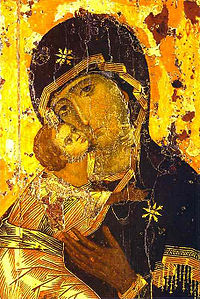
A great many traditions revolve around the Ever-Virgin Mary, the Theotokos, in Orthodoxy. It is believed by Orthodox Christians that she was and remained a Virgin before and after Christ's birth. Many of the Church's beliefs concerning the Virgin Mary are reflected in the apocryphal text "The Nativity of Mary", which was not included in scripture, but is considered by Orthodox faithful to be accurate in its description of events. This tells that the child Mary was consecrated at the age of three to serve in the temple as a temple virgin. Zachariah, at that time High Priest of the Temple, did the unthinkable and carried Mary into the Holy of Holies as a sign of her importance – that she herself would become the ark in which God would take form. At the age of twelve she was required to give up her position and marry, but she desired to remain forever a virgin in dedication to God. And so it was decided to marry her to a close relative, Joseph, an uncle or cousin, an older man, a widower, who would take care of her and allow her to retain her virginity. And so it was that when the time came she submitted to God's will and allowed the Christ to take form within her. It is believed by many Orthodox that she, in her life, committed no sin; however, the Orthodox do not accept the Roman Catholic doctrine of the Immaculate conception. In the theology of the Orthodox Church, from the very moment of conception, Christ was fully God and fully man. Therefore Orthodox Christians believe that it is correct to say that Mary is indeed the Theotokos, the Birth-giver of God, and that she is the greatest of all humans ever to have lived except for Christ her Son.
After the birth of Jesus the Orthodox Church believes that she remained a virgin, continuing to serve God in all ways. She travelled much with her son, and was present both at his Passion on the Cross and at his ascension into heaven. It is also believed that she was the first to know of her son's resurrection – the Archangel Gabriel appearing to her once more and revealing it to her. It is believed she lived to the age of seventy and called all the apostles to her before she died. According to tradition Saint Thomas arrived late and was not present at her death. Desiring to kiss her hand one last time he opened her tomb but her body was gone. The Orthodox believe she was assumed into heaven bodily; however, unlike in the Roman Catholic Church, it is not a dogmatic prescription, and the holy day is usually referred to as the Feast of the Dormition, rather than the Assumption.
Theologians from the Orthodox tradition have made prominent contributions to the development of Marian thought and devotion. John Damascene (c 650 - c 750) was one of the greatest Orthodox theologians. among other Marian writings, he proclaimed the essential nature of Mary's heavenly Assumption, or dormition, and her mediative role.
It was necessary that the body of the one who preserved her virginity intact in giving birth should also be kept incorrupt after death. It was necessary that she, who carried the Creator in her womb when he was a baby, should dwell among the tabernacles of heaven...[41]
From her we have harvested the grape of life; from her we have cultivated the seed of immortality. For our sake she became Mediatrix of all blessings; in her God became man, and man became God.[42]
Protestant views
Protestants typically hold that Mary was the mother of Jesus, but was an ordinary woman devoted to God. Therefore, there are virtually no Marian veneration, Marian feasts, Marian pilgrimages, Marian art, Marian music or Marian spirituality in today's Protestant communities. Within these views, Roman Catholic beliefs and practices are at times rejected as heresy, e.g. theologian Karl Barth wrote that "the heresy of the Catholic Church is its mariology".[43]
Some early Protestants venerated and honored Mary. Martin Luther said Mary is "the highest woman", that "we can never honor her enough", that "the veneration of Mary is inscribed in the very depths of the human heart", and that Christians should "wish that everyone know and respect her". John Calvin said, "It cannot be denied that God in choosing and destining Mary to be the Mother of his Son, granted her the highest honor." Zwingli said, "I esteem immensely the Mother of God", and, "The more the honor and love of Christ increases among men, so much the esteem and honor given to Mary should grow". Thus the idea of respect and high honor was not rejected by the first Protestants; but, they came to criticize the Roman Catholics for blurring the line, between high admiration of the grace of God wherever it is seen in a human being, and religious service given to another creature. The Roman Catholic practice of celebrating saints' days and making intercessory requests addressed especially to Mary and other departed saints they considered (and consider) to be idolatry. Protestantism usually follows the reformers in rejecting the practice of directly addressing Mary and other saints in prayers of admiration or petition, as part of their religious worship of God.
Today's Protestants acknowledge that Mary is "blessed among women" (Luke 1:42) but they do not agree that Mary is to be venerated. She is considered to be an outstanding example of a life dedicated to God. Indeed the word that she uses to describe herself in Luke 1:38 (usually translated as "bond-servant" or "slave")[44] refers to someone whose will is consumed by the will of another - in this case Mary's will is consumed by God's. Rather than granting Mary any kind of "dulia", Protestants note that her role in scripture seems to diminish - after the birth of Jesus she is hardly mentioned. From this it may be said that her attitude paralleled that of John the Baptist who said "He must become greater; I must become less" (John 3:30).
Lutheran views
Despite Luther's harsh polemics against his Roman Catholic opponents over issues concerning Mary and the saints, theologians appear to agree that Luther adhered to the Marian decrees of the ecumenical councils and dogmas of the church. He held fast to the belief that Mary was a perpetual virgin and the Theotokos or Mother of God.[45] Special attention is given to the assertion, that Luther some three-hundred years before the dogmatization of the Immaculate Conception by Pope Pius IX in 1854, was a firm adherent of that view. Others maintain that Luther in later years changed his position on the Immaculate Conception, which, at that time was undefined in the Church, maintaining however the sinlessness of Mary throughout her life.[46] Regarding the Assumption of Mary, he stated, that the Bible did not say anything about it. Important to him was the belief that Mary and the saints do live on after death.[47] "Throughout his career as a priest-professor-reformer, Luther preached, taught, and argued about the veneration of Mary with a verbosity that ranged from childlike piety to sophisticated polemics. His views are intimately linked to his christocentric theology and its consequences for liturgy and piety."[48] Luther, while revering Mary, came to criticize the "Papists" for blurring the line, between high admiration of the grace of God wherever it is seen in a human being, and religious service given to another creature. He considered the Roman Catholic practice of celebrating saints' days and making intercessory requests addressed especially to Mary and other departed saints to be idolatry.[49]
See also
- Ecumenical views of Mary
- The Glories of Mary
- Marian doctrines of the Catholic Church
- Marian theology
- Mariology (disambiguation)
- Protestant views on Mary
References
- ↑ "Mary, The New Eve". http://campus.udayton.edu/mary//meditations/neweve.html. Retrieved October 8, 2008.
- ↑ A. Cameron, "The Theotokos in sixth-century Constantinople", Journal of Theological Studies, New Series 19 (1978:79-108).
- ↑ John L. Osborne, "Early Medieval Painting in San Clemente, Rome: The Madonna and Child in the Niche" Gesta 20.2 (1981:299-310) and (note 9) referencing T. Klauser, "Rom under der Kult des Gottesmutter Maria", Jahrbuch für der Antike und Christentum 15 (1972:120-135).
- ↑ M. Mundell, "Monophysite church decoration" Iconoclasm (Birmingham) 1977:72.'
- ↑ Liber Pontificalis, I, 317.
- ↑ First mentioned under this new dedication in the Salzburg Itinerary, undated but first half of the seventh century (Maria Andalore, "La datazione della tavola di S. Maria in Trastevere", Rivista dell'Istituto Nazionale d'Archeologia e Storia d'Arte, New Series 20 [1972-73:139-215], p. 167).
- ↑ Liber Pontificalis, I, 376.
- ↑ International Standard Bible Encyclopedia: K-P by Geoffrey W. Bromiley 1994 ISBN 0802837832 page 272
- ↑ Daughters of the church 1987 by Ruth Tucker ISBN 0310457416 page 168
- ↑ Vatican website for Pope Paul VI's Apostolic Constitution Indulgentiarum Doctrina [1]
- ↑ Zenit News 2008 Cardinal Urges Devotion to Rosary and Scapular
- ↑ Pope John Paul II's encyclical Rosarium Virginis Mariae http://www.vatican.va/holy_father/john_paul_ii/apost_letters/documents/hf_jp-ii_apl_20021016_rosarium-virginis-mariae_en.html
- ↑ Ann Ball, 2003 Encyclopedia of Catholic Devotions and Practices ISBN 087973910X
- ↑ Vatican website: Lumen Gentium No 61 and No 62 [2]
- ↑ Mark Miravalle, 1993, Introduction to Mary, Queenship Publishing ISBN 9781882972067, page 173
- ↑ Vatican website, General Audiences
- ↑ Pope John Paul II, 1996, Gift And Mystery, Doubleday Books ISBN 9780385409667 page 28
- ↑ Ann Ball, 2003 Encyclopedia of Catholic Devotions and Practices ISBN 087973910X
- ↑ Catholic Encyclopedia http://www.newadvent.org/cathen/12620a.htm
- ↑ Joseph P. Christopher et al., 2003 The Raccolta St Athanasius Press ISBN 978-0970652669
- ↑ Short Biography of Padre Pio http://www.padrepiodevotions.org/index.asp?pagename=biography
- ↑ The book Mother Maria Pierina by Maria Rigamonti http://www.cenacle.co.uk/products.asp?partno=B0532
- ↑ Graduale Romanum, Kyriale IX And X.
- ↑ (Sub tuum praesidium, Seven Dolours of the Virgin, Seven Joys of the Virgin)
- ↑ In Germany, in the monastery of Andechs, Father Nonnosus Madleder, in Ottobeuren, Father Franx Schnizer, in Irsee Father Meinrad Spiess, and in Banz
- ↑ Missa in honorem Beatissimae Virginis Mariae, No. 5 in E flat major,, also known as the Grosse Orgelmesse (Great Organ Mass) (H. 22/4) (1766) and Missa Cellensis, Mariazellermesse No. 8 in C major, (H. 22/8) (1782)
- ↑ Dixit & Magnificat KV 193: C-Major, Regina Coeli KV 108: C- Major, Regina Coeli KV 127: B- Major, Graduale Sancta Maria KV 273, Offertorium Alma Dei creatoris KV 277, Litaniae de Beata Maria Virgine KV 109
- ↑ www.catholicculture.org/liturgicalyear/prayers/view.cfm?id=758
- ↑ www.wf-f.org/Rosary.html
- ↑ Memorials of the Blessed Virgin Mary
- ↑ This dogma was declared by the Council of Ephesus in A.D. 431. The first of twelve anathemas proposed by Cyril of Alexandra and accepted by the Council declares:
- 1. If anyone does not confess that Emmanuel is God in truth, and therefore that the holy virgin is the mother of God (for she bore in a fleshly way the Word of God become flesh), let him be anathema.
- ↑ This dogma is based in part on the scripture in which Elizabeth greets Mary stating: "And how does this happen to me, that the mother of my Lord should come to me?" (Luke 1:43)
- ↑ Schmaus, Mariologie, München, 1955, 328
- ↑ The Second Council of Constantinople stated in the Fourteen anathemas:
2. If anyone will not confess that the Word of God has TWO nativities, that which is before all ages from the Father, outside time and without a body, and secondly that nativity of these latter days when the Word of God came down from the heavens and was made flesh of holy and glorious Mary, Mother of God and Ever-Virgin, and was born from her: let him be anathema.
- ↑ The scripture verse commonly cited for her perpetual virginity is
Then said the LORD unto me; This gate shall be shut, it shall not be opened, and no man shall enter in by it; because the LORD, the God of Israel, hath entered in by it, therefore it shall be shut. (Ezekiel 44:2)
This represents a point of divergence within the Christian world, with Protestant Christians teaching that Mary did in fact have other children, described in the Bible as Jesus' brothers and sisters, in verses such as Matthew 13:55-56 and Mark 6:3. The meaning of the word adelphos in the original Greek texts is disputed, viewed on the one hand as literally meaning brethren/brother, or by Roman Catholic, Eastern Orthodox and Oriental Orthodox Churches as meaning male cousin, male friend, etc. Within the New Testament the word appears over 346 times. Alternatively, many Eastern (and some Western) Christians (both Catholic and Orthodox) teach that the "brothers and sisters" of Jesus referenced in the Scriptures were children of Joseph from a previous marriage.
While the perpetual virginity of Mary is seen as having immense importance to Catholic teaching, Protestants' rejection of the doctrine is not considered spiritually significant for them. Although they object to what they see as extra-Biblical traditions, it is of no consequence to Protestant Christianity whether Mary did or did not have other children after Jesus. Protestant theology teaches that God intended Mary and Joseph as husband and wife "to become one flesh" (Genesis 2) and that the New Testament commanded Mary to fulfill her marital role to her husband Joseph. (1 Corinthians 7:5) - ↑ Scripture verses sometimes used in support of belief in the Immaculate Conception include Luke 1:28 and
"So I made an ark of boards of incorruptible wood, and I hewed tables of stone like the first, and I went up to the mountain, and the two tables were in my hand." (Deuteronomy 10:3 Breton LXX)
Other translations use the words "setim", "acacia", "indestructible", and "hard" to describe the wood used. In any case, Moses used this wood because it was regarded as very durable and "incorruptible". The Ark of the Covenant has been regarded by both Roman Catholic and Orthodox Christians as being the "type" in typological terms in the Old Testament of Mary and therefore it has been considered fitting that the New Ark likewise be made "incorruptible" or "immaculate".
Protestants hold that the dogma means that Mary has no need for a savior and is in violation of Romans 3 where it is declared that all have sinned and that no one is righteous (unless saved by Jesus).
Catholics say that Mary's preservation from original sin, that is, her immaculate conception is not the same as her preservation from actual sin, since original sin is not an actual sin a person commits but a state of deprivation of sanctifying grace. This lack of sanctifying grace is what inclines us toward sin. Mary, having been given sanctifying grace from the moment of her conception, lacked the inclination to sin. However, even being sinless, Mary was still in need of a savior, for it is precisely the work of the savior that preserved her from both original sin and actual sin. A person can be saved from actual sin after falling into sin and can be saved before ever falling into sin. For Catholics, Mary was preserved from original sin before contracting it and from actual sin before falling into sin. Catholics believe that Jesus could not have been born into a sinful vessel.
Yet Protestant churches hold that Jesus' mission was to overcome sin and do not recognize the difficulty in Jesus being born to an ordinary woman which Catholics view as impossible. Protestants argue that conquering sin and cleansing the world from sin was Jesus' purpose in entering a fallen and sinful world and do not view Jesus as needing a birth mother to be anything but an ordinary woman. What Catholics categorically reject does not gather much attention from Protestants, who readily dismiss the problem with the idea that "with God all things are possible"
Meanwhile, Orthodox Christians and many Protestants view the dogma as erroneous and unnecessary. Catholics, Orthodox, and most Protestant Christians view original sin as imposing a tendency toward evil and an inclination to sin, drawing people towards sin. They believe a person is actually guilty only for sins he actually commits. But the Orthodox and most Protestants depart from Catholic beliefs in believing that Mary, being born with original sin would have this inclination to sin but she remained sinless because she did not commit any sins; instead, she dedicated her whole life to God from the beginning. - ↑ Nicea II Session 6 Decree
- ↑ Nicaea II Definition, "without blemish"
- ↑ Blessed Virgin Is Mother Of The Church
- ↑ From the website of Zenit news agency
- ↑ Damascene, John, Homily 2 on the Dormition 14; PG 96, 741 B
- ↑ Damascene, John, Homily 2 on the Dormition 16; PG 96, 744 D
- ↑ Barth, Kirchliche Dogmatik, I, 2, 157
- ↑ Doulos - Strong's Concordance
- ↑ Remigius Bäumer, Marienlexikon Gesamtausgabe, Leo Scheffczyk, ed., (Regensburg: Institutum Marianum, 1994), 190.
- ↑ Bäumer, 191
- ↑ Bäumer, 190.
- ↑ Eric W. Gritsch (1992). H. George Anderson, J. Francis Stafford, Joseph A. Burgess (eds.). ed. The One Mediator, The Saints, and Mary, Lutherans and Roman Catholic in Dialogue. VII. Minneapolis: Augsburg Fortress. pp. 235.
- ↑ Luther's Works, 47, pp. 45f; see also, Lutherans and Catholics in Dialogue VIII, p. 29.
External links
- The doctrine of the Immaculate Conception according to the Catholic Encyclopedia
- Mariology.com, " a resource for understanding the role of Mary, the mother of Jesus Christ"
- List of the memorials, feasts, and patronages of the Blessed Virgin Mary
- Homily on the Queenship of Mary by the Catholic Doors Ministry
 "The Blessed Virgin Mary". Catholic Encyclopedia. New York: Robert Appleton Company. 1913.
"The Blessed Virgin Mary". Catholic Encyclopedia. New York: Robert Appleton Company. 1913.- The Mary Page (The Marian Library/International Marian Research Institute, University of Dayton)
|
|||||||||||||||||||||||||||||
|
||||||||||||||||||||||||||||||||||||
